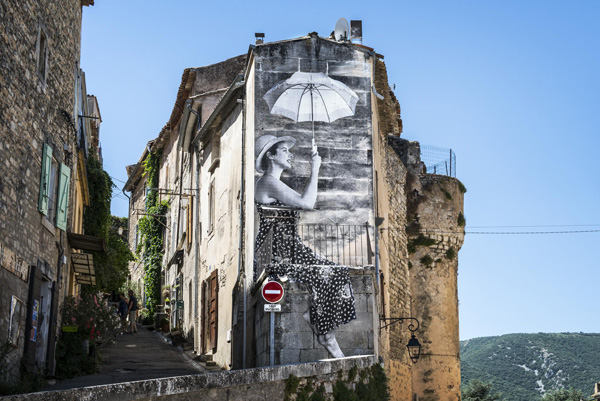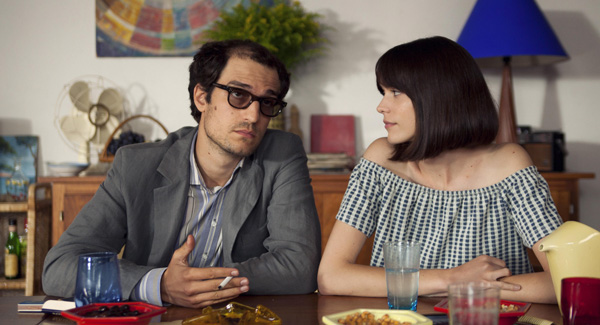![]() The reclusive Jean-Luc Godard is everywhere and nowhere at Cannes this year. He’s something of a ghost in Agnès Varda’s wistful and engaging Visages Villages (Faces Places), in which she co-directs with hipster street artist JR, 55 years her junior; they are so in-sync that she wonders why they hadn’t met earlier.
The reclusive Jean-Luc Godard is everywhere and nowhere at Cannes this year. He’s something of a ghost in Agnès Varda’s wistful and engaging Visages Villages (Faces Places), in which she co-directs with hipster street artist JR, 55 years her junior; they are so in-sync that she wonders why they hadn’t met earlier.
This was an appropriate choice for my first film at this year’s festival, given that it’s the 70th anniversary of Cannes, and Varda is one of the few artists from the 1960s French New Wave still active. She’s also only one of two women filmmakers who have received the Palme d’Or. Hers was honorary; Jane Campion won for The Piano. Though Varda’s latest acknowledges the passing of the years, it is also of the here and now.
Though this is a team effort, make no mistake, this is her film, in keeping with earlier works such as The Gleaners & I, part-documentary and part-road trip, in which she and JR self-consciously take on the roles of the “wise grandma” and the “spirited young man.” They are certainly dressed for their parts. He wears a black fedora and always, and I mean always, wears shades, while the diminutive 88-year-old stands out in any crowd, thanks to her bobbed white hair with scarlet red trim.
The pair crisscross the country, photographing what grabs their eye, commemorating everyday people and places, often connecting the past with the present. (“Chance has always been my best assistant:” Varda.) Their mobile photo booth then spits out giant black-and-white photos, which the two plaster in situ, such as on the sides of buildings. Appropriately, the Museum of Modern Art is one of the film’s producers.
Among the destinations, the duo venture to an abandoned village, a mining ghost town, and, in particular, to the Brittany Coast, where Varda took photos during the mid-1950s. In a tribute to her model and friend, fellow photographer Fouli Elia, she returns to the spot where she photographed him on the beach. Though no longer living, he becomes a collaborator once again when she pastes the image of Elia reclining against a beach hut on a German bunker that had been tossed down from the cliff, piercing the beach.
Melancholic and whimsical, the film takes in the world at large. While a personal work, it embraces its surroundings, and for those who have followed French films, it will assuredly have a special resonance. Through fleeting glimpses of Varda’s oeuvre, the film is a reminder of how varied her career has been. (To put on a watch list: her 1981 film Murs Murs, on the murals of Los Angeles, which seems like a companion piece to the new film.)
Still, all roads lead to Godard for a startlingly moment when Varda and JR journey to Switzerland to rendezvous with the reclusive director, who was once part of a foursome: Varda; her late husband, director Jacques Deny; Godard; and his then-wife, Anna Karina. She has brought Godard’s favorite pastry and arrives at her old friend’s house at the appointed time. He’s not there, but has left a cryptic note on the window pane. The tenor of the film entirely changes; the jaunt has startlingly hit its only rough patch, leading Varda to calling him a dirty rat. Given the circumstances, he could have been called worse, as he is the following film.
Though in some ways a tribute to Godard, Michel Hazanavicius’s footloose biopic The Redoubtable steers clear of becoming a hagiography. This was by far the most carefree and playful of the 12 French films I saw at Cannes, and it’s a return of the nimble trickster Hazanavicius from The Artist, not the director who made the big-budget dud The Search three years ago.
It’s based on the memoirs of Godard’s second wife, Anne Wiazemsky, who was a 19-year-old philosophy student when she married the director. She also played his leading lady (as his first wife, Anna Karina, whom actress Stacy Martin more closely resembles, once did) in his 1967 dialogue-drenched La Chinoise, about love and revolution among Parisian Maoists. Wiazemsky had just starred in Robert Bresson’s Au Hasard Baltazar.
Viewers of all stripes, and not only film buffs and Francophiles, will gravitate toward this irreverent romp. The film doesn’t take itself seriously (unlike the Godard portrayed here by Louis Garrel, toning down his good looks and amping up his inner nerd). Rather, it acknowledges his place in French film history, while sending up his ego.
Stripped down, the movie straightforwardly covers the beginning of Godard’s fall from grace, at least for many moviegoers. (Gone is the temperament that made Breathless.) In 1967, at age 36, the incredibly prolific and game-changing filmmaker feels driven to top himself. He acts as though he’s already irrelevant, and has declared that only the movies of the Marx Brothers and Martin and Lewis will be worth saving. He becomes the oldest grandstander at university protests, where he tries too hard to act the iconoclast, often going off the deep end (“Jews have now become today’s Nazis.”).
With a wink, the film skewers the image of the authoritarian auteur (the first chapter is “Wolfgang Amadeus Godard”; another is entitled “Everything Is Brighter with Mao”), and Hazanavicius borrows from a 1960s filmmaking grab bag, between the vibrant production design to the manipulation of sound, to name just a few tricks. However, it’s odd that Wiazemsky takes on a reticent role in her own story, though Hazanavicius’s Godard does make it hard for anyone to get in a word edgewise.
The film also depicts Godard, along with other filmmakers, wanting to shut down the 1968 Cannes Film Festival in protest against the structure of the country’s film industry and in solidarity with the striking workers and demonstrating students. The event was, in fact, interrupted by the unrest. But instead of protesting in Cannes, Godard and Wiazemsky have an idyllic sojourn on the Riviera, though he rallies against the villa’s capitalist owner (while accepting the hospitality).
It’s difficult to imagine a complete shutdown happening today; the festival is the country’s biggest media event. It’s also a well-run, unstoppable machine. No matter that the streets and screening rooms are congested and the accommodations exorbitant, let alone that the selections are of unpredictable quality. The number of films to recommend, without hesitation, was fewer in number than in 2013, 2014, or 2015. Even those who have sworn not to return the following year eventually give in. The lure of binging on films, and the search for that one favorite film, is too strong to resist.


















Leave A Comment